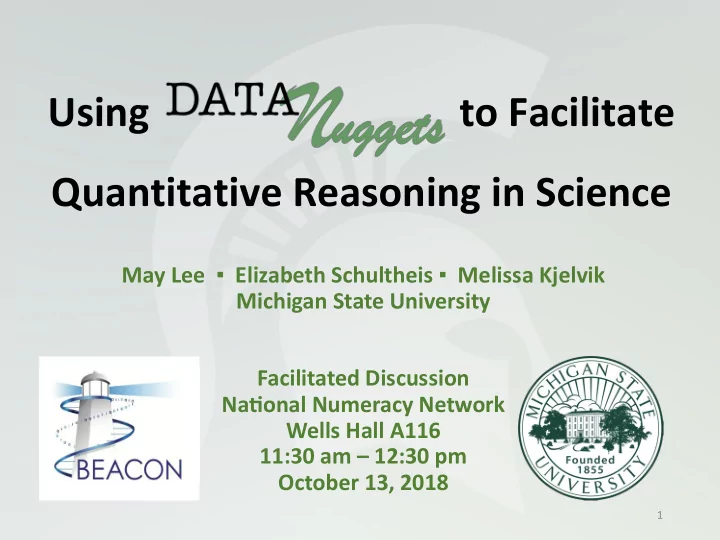

Using to Facilitate Quantitative Reasoning in Science May Lee ▪ Elizabeth Schultheis ▪ Melissa Kjelvik Michigan State University Facilitated Discussion NaBonal Numeracy Network Wells Hall A116 11:30 am – 12:30 pm October 13, 2018 1
Introductions
Goals Address quantitative reasoning in the sciences • (introduce adaptation of Mayes’ framework) Engage with a Data Nugget activity to identify • instances students use quantitative reasoning Report current research findings on secondary • students’ performances on Data Nuggets – with respect to data interpretation in scientific arguments
Context Data exists everywhere (e.g., public repositories, citizen data, simulations) … …which makes for variations in its complexity (e.g., outliers, missing values, variability) Students struggle to make sense of this complexity with respect to: • identifying relevant data to answer (scientific) questions about the world • synthesizing data for analysis • visualizing patterns in data (may require technology) Quantitative reasoning can assist students in making sense of the complexities in data, especially in science.
Shifts in Science Education Science instruc+on is moving… …away from the rote memoriza+on of facts …towards cri+cal thinking through 3D learning (NGSS, 2013) • disciplinary core ideas (physical science, life science, earth & space science, engineering/technology/application of science) • scientific and engineering practices (asking questions, developing & using models, planning & carrying out investigations, analyzing & interpreting data, using mathematics & computational thinking, constructing explanations and designing solutions, engaging in argument from evidence, obtaining/evaluating/communicating information) • cross-cutting concepts (patterns, cause & effect, scale/proportion/ quantity, systems & system models, energy & matter, structure & function, stability & change)
Science 1. Asking questions and defining problems What patterns will I see? 3. Planning and carrying out investigations 2. Developing and using models 4. Analyzing and interpreting data Quantitative Abstracted Real-World Reasoning Representations Phenomena 6. Constructing explanations and designing solutions 7. Engaging in argument from evidence 8. Obtaining, evaluating, and communicating information 5. Using mathematics and What do these relationships mean? computational thinking
Quan%ta%ve Reasoning A way of viewing the world through • “mathematical eyes” and approaching everyday problems with confidence and logical reasoning (Piatek-Jimenez et al., 2012; Vacher, 2014) Mathematics and statistics applied in real- • life, authentic situations that impact an individual’s life as a constructive, concerned, and reflective citizen (Mayes et al., 2014)
Data Nuggets Repeated analyses of authentic data, which are • often complex, can help build students’ abilities to quantitative reason about science phenomena, in addition to gaining proficiencies with scientific practices and cross-cutting concepts. Data Nuggets are free activities (71!) that provide • authentically complex data for students to analyze from the scientists’ investigations.
Time for Data Nuggets!
Sample Activities The Mystery Do Insects Prefer When a Species of Plum Island Local or Foreign Can’t Stand the Marsh Foods? Heat quantitative mean, statistics addition, percent, mean concepts (variance, SD, SE, CI) ratio, regression summarized, type of data raw, categorical raw, continuous categorical bar graphs scatter plots type of graph bar graph (series) (coordinated)
Science What patterns will I see? Quantitative Abstracted Real-World Reasoning Representations Phenomena What do these relationships mean?
Share Out How did your mappings of the activity compare to • each other? Do you think the context of authentic data would • affect how a student might apply quantitative reasoning with the data?
Current Research 17 students from a high school biology class in • the Midwest (part of larger research project) engaged with 8 Data Nuggets in Fall 2017 • evaluated students’ CER responses •
CER Rubric Claims Evidence Reasoning 1. answers the presented 1. provides 1. states how/why claim scientific question appropriate data is supported by that supports claim evidence 2. describes relationship between independent 2. provides sufficient 2. identifies appropriate and dependent data to support underlying science variables claim concepts 3. does not include 3. references specific 3. identifies sufficient evidence or reasoning data relevant to underlying science claim concepts 4. articulates idea clearly 4. articulates idea clearly
Current Findings
Next Steps Complete scoring of student responses for • remainder of this class, and other classes Identify aspects of CER (e.g., quantitative • reasoning involved in supporting claims with evidence) students may find challenging. Informative to researchers and educators • interested in improving students’ scientific and quantitative literacies.
Thank You! website datanuggets.org e-mail datanuggetsk16@gmail.com twitter @Data_Nuggets facebook https://www.facebook.com/DataNuggets/
Recommend
More recommend